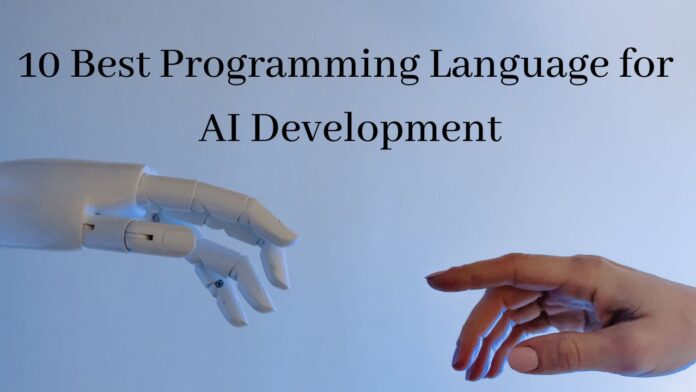The impact of AI on the globe has been far-reaching and unprecedented. Many individuals, particularly younger ones, don’t realize it because they assume AI has always existed in society. Around 37% of corporations and organizations now use AI. Recent years have seen the introduction of a wide range of algorithms, from specialized recommendation systems to interactive humanoid robots. Yet, the effects of these AI examples are limited to the global scale.
Artificial intelligence (AI) is used by businesses to improve production, management, and customer satisfaction, which is more relevant here. AI’s progress seems ideal, with its potential uses in areas such as analytical decision-making, automating, decreasing error rates, and data mining. The first step in developing AI is selecting the appropriate programming language.
Why Should You Employ AI for Your Upcoming Project?

AI aims to simplify everyday tasks like scheduling appointments, managing a home or workplace, or even driving a vehicle. About 51% of online retailers rely on AI to deliver a smooth customer experience. Therefore, picture a scenario where your tech is smart enough to anticipate and provide for your requirements. Doing this would make your every day more enjoyable and freer of worry and provide additional time to spend on yourself.
In What Ways Does Artificial Intelligence Operate?
The information its users provide to an AI system is crucial to its success. There is an abundance of tech that uses AI. Around 77% of devices employ some AI system. The size of its error range is proportional to the reliability of these numbers. Regularly providing your AI system with sufficient and reliable data can increase its efficacy, dependability, and precision. The three cognitive abilities that AI acquires to improve its efficiency are:

- Procedures for Learning: It’s a kind of AI software that gathers pertinent information to create rules for turning raw data into valuable insights. Algorithms are the rules that tell computers what to do and how to do it systematically.
- Mechanisms for Reasoning: The appropriate AI algorithm for accomplishing a task is identified throughout this programming procedure.
- Procedures for Self-Correction: This branch of AI programming constantly adjusts algorithms to improve accuracy, resulting in reliable outcomes.
Top 10 Languages for Artificial Intelligence Development

Several languages are available for use in the creation of AI. The top 10 programming languages for creating AI and machine learning systems are the following:
Python
Python is the most often used language for AI development because of its accessibility and widespread use. It has several uses in networking, desktop software, the internet, science, data science, AI, and ML. It’s ready for AI development because of its extensive collection of libraries like PyTorch, MXNet, Keras, Pybrain, TensorFlow, and Scikit-learn.
Python’s easy syntax is ideal for AI and NPL (Natural Language Processing) applications, and it also provides enhanced text processing tools, programming with modular layouts, and more. Python’s conciseness and clarity make it easy to pick up and master. In addition, there is a sizable community of dedicated users behind it.
Haskell
The winning features of Haskell are its speed and security. Haskell is a cutting-edge, completely functioning programming language with many practical applications in AI. Its more sophisticated features include type classes, which make type-safe operator overloading possible.
Lambda expressions, pattern matching, type classes, type polymorphism, and list comprehension are more characteristics. Haskell’s rich features make it well-suited for educational and professional use. Haskell is one of the most secure AI programming languages due to its adaptability and mistake-handling capability.
Lisp
From its inception in the 1960s, Lisp has seen extensive application in academia, particularly for studying natural languages, verifying theorems, and solving AI issues. Lisp was developed as a practical mathematical notation for programming, but AI programmers now widely use it.
Lisp is great for solving problems, iterating quickly, or creating dynamic software. The popular tools like Grammarly, Routinic, and DART were all developed using Lisp. Despite its flaws, Lisp remains a promising programming language for advancements in artificial intelligence.
R
The R Foundation for Statistical Computing maintains R, an open software platform with a programming language for statistical computation and graphic elements. Although not ideal for AI applications, this language excels in number-crunching.
Complex procedures for expressing and analyzing numerical data are fundamental to the development of AI. R outperforms Python in this scenario as it is more adept at handling complicated mathematical equations.
Java
Another language that is popular among AI developers because of its adaptability, friendliness, and wealth of resources. Java is not as quick as other programming languages but is robust and may be used in AI projects.
Importantly, it works on several platforms without constantly changing your code. Java can also create high-quality images. It is not necessary for you to be very concerned with the clarity of the AI graphics.
Prolog
Program in Logic, or Prolog for short, is another computer programming language. In 1972, a rule-based framework for the language was created. It finds most of its usage in computational linguistics and artificial intelligence projects.
Regarding jobs that need a database, natural language processing, and symbolic reasoning, Prolog is the preferred language! It’s the top pick for language support in artificial intelligence exploration.
Scala
Scala improves the efficiency, simplicity, and effectiveness of the coding process. Developers may find useful tools and libraries for working with Scala in the index called Scaladex. It’s compatible with the Java Virtual Machine (JVM) and facilitates the creation of intelligent applications.
Scala is a powerful programming language that is cross-platform with Java and JS and has many valuable features such as pattern matching, browser extensions, fast functions, and adaptable user interfaces. Scala has pleased experts in AI and is considered one of the top solutions for AI development.
Julia
This dynamic language was developed to provide superior performance in numerical analysis and computational research. Since MIT first released the language in 2012, Julia has gained popularity because of its high computing capability, rapid execution, and script-like syntax.
Scikitlearn.Jl, TensorFlow. Jl, Flux, Mocha. Jl and many more are just a few examples of machine learning components that have arisen in recent years to support this language.
C#
Another long-standing language that can still hold its own in artificial intelligence is C#. The language’s extreme adaptability is a significant factor, making it a good fit for demanding programs that need plenty of memory and CPU time. The AI model is best handled in production when written in C#, a low-level language.
C# is considered to be one of the best .NET frameworks. Many developers tends to use libraries like accord.NET and TenserFlow.NET to develop and integrate machine learning frameworks in C#. Therefore companies prefer to hire .NET development company to leverage the best functionality of the .Net framework.
While it’s true that numerous profound machine learning frameworks are developed in C#, this fact is often overlooked by AI developers. In addition, C#’s efficiency and performance are top-notch since it translates user code into machine-readable code.
JavaScript
Most programmers nowadays utilize JavaScript to build more interactive and secure online applications. It is also an excellent language for creating AI. Since JavaScript provides developers unrestricted access to server-side and client-side processes, it simplifies the process of building AI software. This language ensures a brisk pace in creating AI, higher performance, and more safety.
JavaScript enables parallel processing and interaction with several source codes, including HTML and CSS. That’s an essential quality for advancing AI. Also, this programming language has a sizable community that may assist programmers. React.js, Underscore.js, and jQuery are a few JavaScript frameworks that make creating AI easier.
Conclusion
Incorporating AI into anything that impacts daily life marks the arrival of the technological future. AI has increased in popularity to enhance professional and personal endeavors. A surprising truth about AI is that just 34% of customers know they are encountering AI in some form or another.
Many languages are available to programmers, a boon for developers looking to improve AI software. The ideal language for oneself is the one in which you can express yourself effectively. If you are starting, choosing a language that makes the development process easier is essential since this will help you the most.






